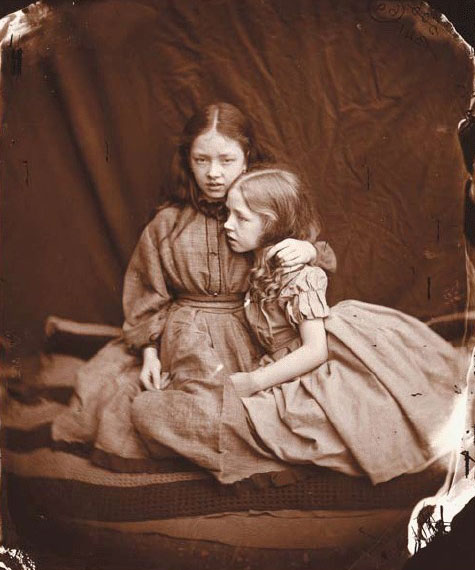- Relief printing
- Intaglio and planographic printing
- Color printing
- Bits and pieces
- Early photography in silver
- Non-silver processes
- Modern photography
- Color notes
- Color photography
- Photography in ink: relief and intaglio printing
- Photography in ink: planographic printing
- Digital processes
- Where do we go from here?
Wet-plate photography

Wet-plate. Lewis Carroll. The Terry Sisters. 1875. 6 x 5" (15.2 x 12.7 cm). Printed by Richard Benson, 1980. The Museum of Modern Art, New York. Gift of Richard Benson.
Early photographs on paper were poor in their rendition of tone and detail because the negative image was imbedded in the rough paper of the support. The negatives were usually waxed, to make them translucent and to reduce the effect of the paper’s fibers, but even so the images they produced could not compete with the daguerreotype for precision and exactness. A tremendous improvement came in the 1850s with the invention and refinement of the wet-plate process, which used a glass support for the negative and captured sharp, intricately detailed images that could be printed with a long and smooth range of tones. We can say with some confidence that with the wet-plate process the image quality of black and white photography reached a level that matches anything done since.

Detail of Wet-plate. Lewis Carroll. The Terry Sisters. 1875. 6 x 5" (15.2 x 12.7 cm). Printed by Richard Benson, 1980. The Museum of Modern Art, New York. Gift of Richard Benson. Like the daguerreotype, a print from a glass-plate negative has superb tonal description, as we can see in this six-times enlargement from the print.
The process only worked when the coated glass plate was exposed while still damp, which meant that the photographer working outside the studio needed a portable darkroom. Hardworking photographers lugged their plates and cameras all over the world, and since no good enlargement process existed—printing was only done by direct contact between negative and paper—those plates and cameras were generally as large as possible.

